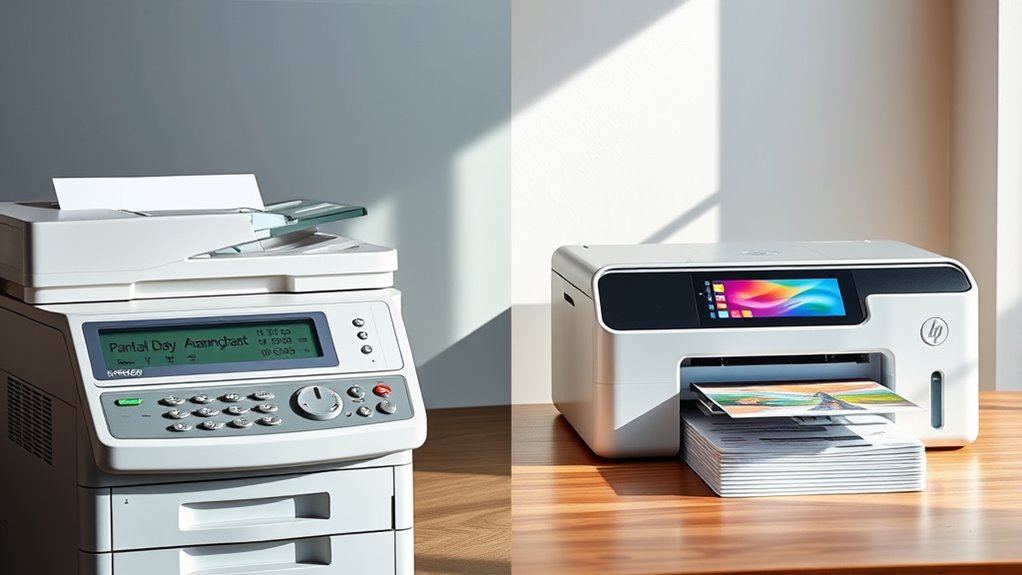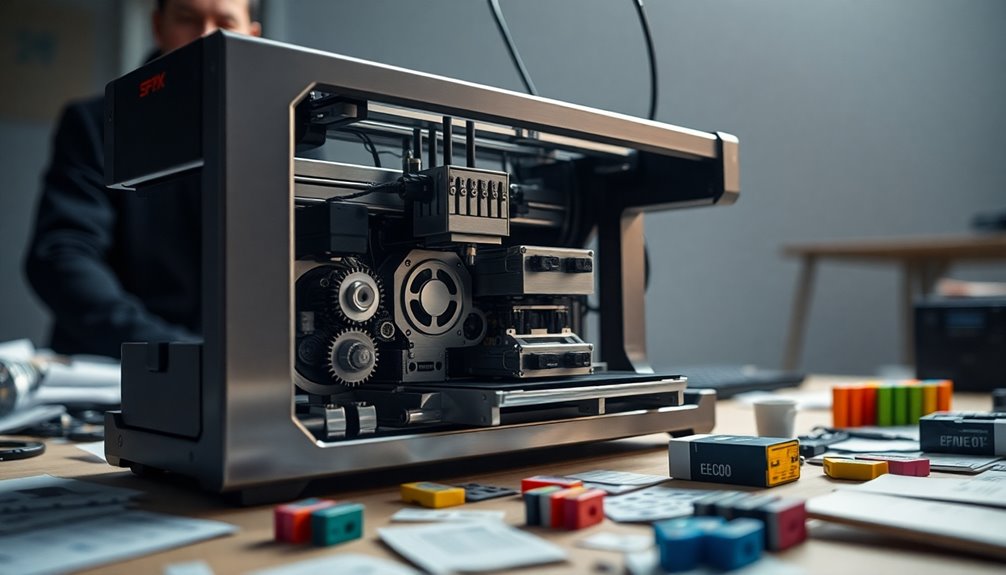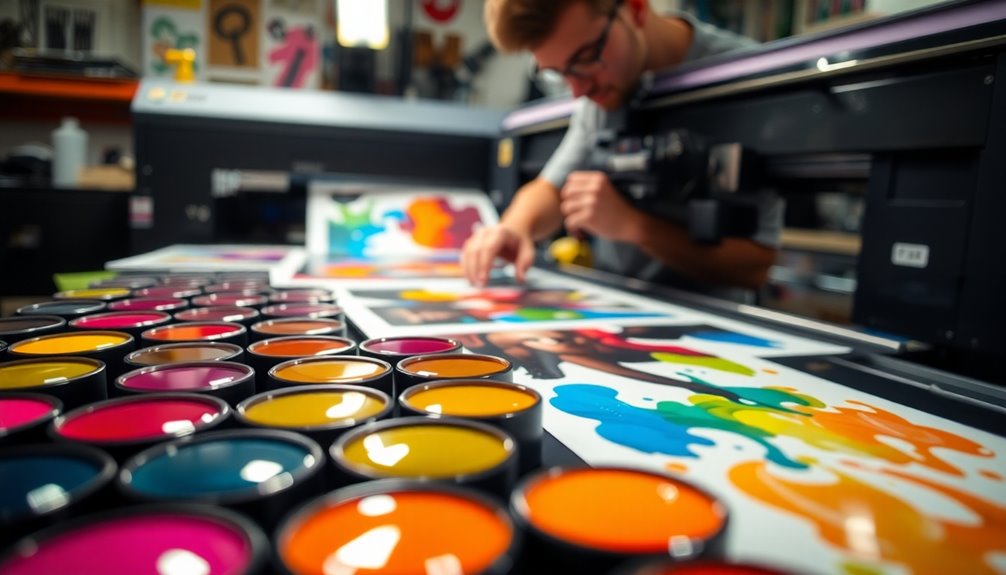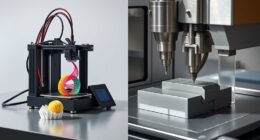When comparing photocopying and digital printing, digital printing offers better color accuracy, sharper images, and more customization options, making it ideal for high-quality projects. Photocopying is faster and more cost-effective for large volumes of simple documents but falls short with vibrant colors and detailed visuals. If you want professional results with precise colors and personalization, digital printing is the way to go. Keep exploring to discover which method best suits your specific needs.
Key Takeaways
- Photocopying is quick and cost-effective for bulk basic document reproduction, while digital printing offers higher quality and color accuracy for smaller runs.
- Digital printing provides sharp images, vibrant colors, and supports various paper types, unlike photocopiers which may produce duller results.
- Photocopying relies on toner transfer without precise calibration, whereas digital printing uses advanced color management for consistent output.
- Digital printing allows for customization, variable data, and personalized projects, whereas photocopying is limited to reproducing existing documents.
- Choose photocopying for large volumes of simple copies; select digital printing for high-quality, colorful, and customized print jobs.

When choosing between photocopying and digital printing, understanding their differences can help you make the right decision for your needs. Both methods serve similar purposes but differ considerably in how they operate, their costs, and the quality they deliver. Photocopying, which has been around for decades, is a quick and straightforward process ideal for reproducing large volumes of documents or images with minimal fuss. It typically offers high cost efficiency for bulk copying because the cost per copy decreases as you produce more copies. However, photocopying has limitations when it comes to color accuracy; it often struggles to reproduce vibrant colors or subtle shades precisely, especially when copying complex images or photographs. If your project demands sharp, true-to-life color reproduction, photocopying might fall short, potentially requiring multiple copies or adjustments, which can add to the overall costs.
Digital printing, on the other hand, is more versatile and offers superior control over color accuracy. It produces high-quality images and sharp text, making it an excellent choice for print-on-demand projects, marketing materials, or items where color fidelity matters. While initial setup costs for digital printing might be higher, it becomes cost-effective for smaller runs or when you need quick turnaround times. Digital printers can handle a variety of paper types and sizes, delivering consistent results with every print. This method also allows for more customization, such as variable data printing, where each copy can be personalized without slowing down production. When considering cost efficiency, digital printing might seem pricier per unit at first, but for shorter runs or projects requiring high-quality visuals, it offers better value by reducing waste and reprints caused by inaccuracies.
In terms of color accuracy, digital printing excels because it utilizes advanced color management systems, ensuring your prints closely match your digital files. Photocopiers rely on toner or ink transfer without precise calibration, which can lead to color shifts or dull results. If your project involves detailed images or branding materials where color precision is critical, digital printing provides a notable advantage. Furthermore, digital printing supports a wide range of color profiles and can reproduce a broader spectrum of hues, giving your project a professional, polished appearance. Ultimately, your choice depends on your specific needs: if you’re producing large quantities of basic documents, photocopying offers a cost-effective, fast solution. But if your focus is on high-quality visuals with accurate colors, digital printing is the better investment, providing clarity and vibrancy that photocopying simply can’t match. Additionally, digital printing’s ability to easily incorporate variable data makes it a flexible option for personalized printing projects.
Frequently Asked Questions
How Does Color Accuracy Differ Between Photocopying and Digital Printing?
You’ll notice color accuracy tends to be better with digital printing because it offers higher color fidelity and consistent ink application. Photocopying often struggles with color accuracy due to less precise color reproduction and variable ink consistency, which can lead to dull or off-color copies. Digital printers use sophisticated color management, ensuring your images look closer to the original, while photocopies may require adjustments for better color matching.
Which Method Is More Environmentally Friendly for Large-Volume Printing?
A picture is worth a thousand words, and choosing the eco-friendlier method depends on your practices. Digital printing is generally more environmentally friendly for large volumes because it reduces waste and uses less energy. By adopting recycling practices and being mindful of energy consumption, you minimize your environmental impact. Switch to digital printing, and you’re helping the planet—because every little bit counts in the fight for sustainability.
What Are the Cost Differences for Small Print Runs?
For small print runs, photocopying tends to be more cost-efficient because it requires minimal setup expenses and offers quick turnaround times. Digital printing, while flexible, usually incurs higher initial costs per job due to equipment setup and ink or toner expenses. If you’re printing just a few copies, photocopying is typically the better choice financially. However, digital printing becomes more cost-effective as volumes increase, thanks to its scalability.
How Quickly Can Each Method Complete Urgent Printing Jobs?
When time is tight, digital printing speeds ahead, often delivering urgent jobs in a flash thanks to high-tech equipment and minimal setup. Photocopying might take longer due to equipment maintenance and slower processes. Digital presses offer superior print quality for quick turnaround jobs, ensuring your project looks sharp. You can count on digital printing to meet tight deadlines while maintaining excellent quality, so you’re not left in the lurch.
Are There Specific Materials or Paper Types Better Suited for Each Method?
You’ll find that photocopying works best with standard paper, but for specialty papers or coated stock, digital printing excels. Digital printers handle thicker or textured materials better, providing crisp, vibrant results without jams or smudges. If you need to print on glossy or coated surfaces, digital printing offers superior quality. For simple black-and-white copies on regular paper, photocopying is quick and cost-effective, but for high-quality, specialized materials, digital printing is the way to go.
Conclusion
In the end, choosing between photocopying and digital printing is like picking the right tool for your project’s story. If you need quick, cost-effective copies, photocopying is your trusty sidekick. But if you crave vibrant, customized prints, digital printing is your canvas. Think of it as a dance—each has its rhythm and purpose. By understanding their strengths, you’ll guarantee your print needs hit the bullseye every time.









